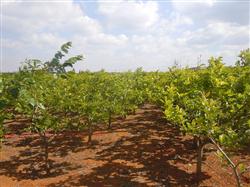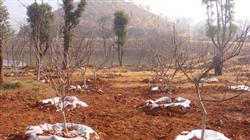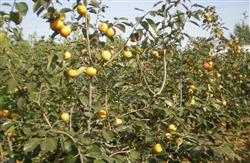How can sweet persimmon be planted with high yield?

How can sweet persimmon be planted with high yield? Please give guidance on the planting methods of sweet persimmon can be referred to as follows: first, the environment requires that sweet persimmon can be cultivated in areas with an average annual temperature of 13: 18 ℃; an average temperature of 18 ℃ during fruit maturity from June to August (1600 to 1900 meters above sea level in Shilin County); sunshine hours above 1400 hours from February to August; annual rainfall of 700 to 1200 mm; and a low temperature of 800 to 1000 hours at 7.2 ℃. The requirement of soil is not strict, and the mountains, hills and beaches with soil PH value of 5: 7 can be cultivated. 2. Variety selection Shilin Prefecture successively introduced 21 varieties from Shaanxi Fruit Tree Institute and Nagano Prefecture Fruit Tree Test ground in Japan since 1988. After experiment and demonstration, Jiro and Maegawa Jiro were selected as the popularized varieties. Third, high-standard establishment of the garden (1) reasonable close planting. Adopt medium density planting, 111 plants per mu (plant row spacing 2 × 3 meters). It is more economical than planting 42 plants (4 × 4 meters), 33 plants (4 × 5 meters), 222 plants (1.5 × 3 meters) and 333 plants (1 × 2 meters) per mu. (2) Seedling quality 1. Grafted seedlings: the rhizome is more than 0.8 cm thick and more than 80 cm high, and there are 4-5 full buds in the plastic belt, which requires a more developed root system with more than 3 lateral roots. 2. Seedling (Junqianzi): the ground diameter is more than 0.8 cm, the height is more than 80 cm, and the root system is required to be more developed, with more than 3 lateral roots. (3) the method and time of planting. Dig a planting hole with a diameter of 1 meter and a depth of 0.8 meters or a planting ditch with a width of 1 meter and a depth of 0.8 meters or mechanically turn 0.8 meters deep for planting in the whole garden. If the soil is sour, add 2 kg of quicklime to each plant, mix well with the soil, make a tree plate or planting belt 30 cm above the ground, put the seedlings into the fill, pick up the seedlings while filling, fill slightly higher than the interface, so that the root system is in full contact with the soil, pour water steadily, and cover the plastic film or organic matter. In order to improve the survival rate of sweet persimmon, soak the roots in 100PPM's No. 1 rooting powder diluent or spray the roots for 30 minutes before planting, and leave 0.8m to dry in time after planting. In order to avoid the drought in winter and spring, promote the recovery of root system, and reduce the time of slow seedling in spring, the planting in winter and spring was changed to autumn from October to November. 4. Soil, fertilizer and water management (1) soil management. In the spring and summer of the following year, the weeds were ploughed twice with topdressing in spring and summer. In late May, 10% glyphosate water agent 0.4-0.8 kg 60 times and 200 grams 400 times 600 times per mu were sprayed to control annual weeds. Sow bare-leaf purple flowers in late June, turn into orchards from October to November to improve soil, do ground mulch or do fodder (can produce 3000 kg of fresh grass per mu), and spray 1.5-1.8 kg / mu of glyphosate 40 times per mu when transported down the assimilation flow of perennial weeds from mid-July to late August. Combined with the application of basic fertilizer from October to November, the organic matter was covered with 5cm organic matter after shallow ploughing and sprayed on the moist organic matter after rain with 200 grams of no-deep tillage per mu, which could preserve water, keep heat, increase soil organic matter, avoid white pollution caused by plastic film mulching and reduce the man-hour cost of soil tillage. (2) applying fertilizer scientifically. Sweet persimmon is longer than peach and pear at slow seedling stage, and grows slightly in the first year after planting. In addition to applying sufficient base fertilizer during planting, it is necessary to apply fertilizer frequently and apply thin fertilizer frequently. After sprouting, topdressing once every 10 days or so for 5-6 times, preferably with light human feces and urine, or 50 kg water plus 0.2-0.3 kg urea. From September to November, 30-50 kg of mature organic fertilizer and 1-2 kg of superphosphate were applied per plant, and 1-2 kg of quick-acting compound fertilizer was applied after physiological fruit drop and one month before harvest to promote fruit hypertrophy and flower bud differentiation. At the initial stage of sprouting, trees can be applied less or not when 0.2-0.5 kg ammonium bicarbonate or urea is applied to each tree. Sufficient organic fertilizer, but not rhizosphere topdressing, with extra-root topdressing supplement, can save a lot of chemical fertilizer. (3) timely watering. Yunnan is dry in winter and spring. Before bud, after flowering and during fruit expansion period, topdressing is irrigated once, and then covered with fine dry soil or organic matter to prevent water evaporation. It can also be irrigated with 150-200 grams of dryland dragon per mu, which can play the role of drought resistance and water saving. Click to get more persimmon planting techniques click to get more fruit planting techniques
- Prev

How to plant sweet persimmons?
How to plant sweet persimmons? Sweet persimmon is one of the most treasured persimmons imported from Japan in China. There are more than ten varieties, such as Shinjiro, Fu, Izu, Nishimura and so on. It has high value of nutrition and health care, resistance to storage and transportation, good commerciality, and has excellent development prospects. Now introduce its high-quality and high-yield cultivation techniques as follows:.
- Next

How to fertilize sweet persimmon trees?
How to fertilize sweet persimmon trees? Please give guidance to sweet persimmon trees can refer to the following methods of fertilization: (1) Base fertilizer 1. Apply the annular ditch at the edge of the crown projection, dig a circular ditch with a depth of 30-40 cm, mix the fertilizer with the topsoil, and then bury the soil. This method is mostly used for young trees. 2. Release.
Related
- Moge, come on! The staff of the peasant association in the producing area of cantaloupe were frightened when the crowd gathered.
- Causes and Solutions of low Fruit setting rate of Apple
- Symptoms and control measures of passion fruit virus disease
- Fruit growing lesson: how do apple orchards keep high yields?
- Can you build orchards in the mountains? What are the pros and cons?
- How to manage the coloring period of Crisson grape?
- This paper introduces the processing technology of two kinds of fig products.
- How much is a month for retired teachers in rural areas by 2020?
- How can strawberry planting increase sugar content? We should pay attention to management in many aspects.
- What are the cultivation techniques on how to improve the yield of golden fruit?

